The aircraft cabin environment sensor market stands at the threshold of a decade-long expansion trajectory that promises to reshape aviation safety technology and passenger comfort optimization solutions. The market's journey from USD 780 million in 2025 to USD 1,223 million by 2035 represents substantial growth, demonstrating the accelerating adoption of advanced sensor technology and air quality monitoring optimization across commercial aviation, business aircraft operations, and maintenance service sectors.
The first half of the decade (2025-2030) will witness the market climbing from USD 780 million to approximately USD 960 million, adding USD 180 million in value, which constitutes 41% of the total forecast growth period. This phase will be characterized by the rapid adoption of integrated sensor systems, driven by increasing passenger comfort expectations and the growing need for advanced air quality monitoring solutions worldwide. Enhanced sensing capabilities and automated environmental control systems will become standard expectations rather than premium options.
The latter half (2030-2035) will witness continued growth from USD 960 million to USD 1,223 million, representing an addition of USD 263 million or 59% of the decade's expansion. This period will be defined by mass market penetration of multi-parameter sensing technologies, integration with comprehensive cabin management platforms, and seamless compatibility with existing aircraft environmental control systems. The market trajectory signals fundamental shifts in how aircraft manufacturers approach passenger safety and comfort management, with participants positioned to benefit from growing demand across multiple sensor types and aircraft platforms.
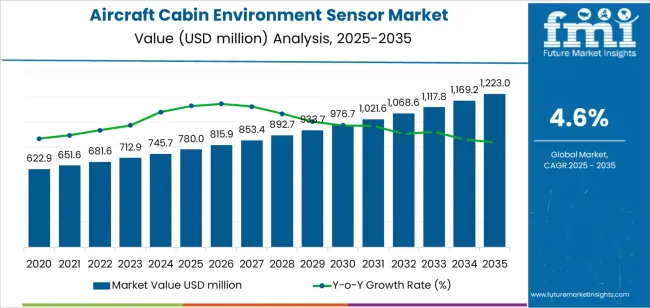
| Period | Primary Revenue Buckets | Share | Notes |
|---|---|---|---|
| Today | Line-fit sensor installations (OEM programs) | 40% | New aircraft deliveries, integrated systems |
| Retrofit & upgrade programs | 22% | Fleet modernization, compliance upgrades | |
| Replacement sensors & components | 20% | Maintenance cycles, component failures | |
| Calibration & validation services | 12% | Regulatory compliance, periodic testing | |
| Data analytics & monitoring software | 6% | Real-time monitoring, predictive maintenance | |
| Future (3-5 yrs) | Integrated sensor suites | 38-42% | Multi-parameter systems, smart cabin integration |
| Retrofit modernization | 18-22% | Aging fleet upgrades, pandemic-driven air quality focus | |
| Predictive maintenance contracts | 15-18% | Sensor health monitoring, failure prediction | |
| Data services & analytics | 12-15% | Cabin air quality insights, compliance reporting | |
| Calibration-as-a-service | 8-10% | Subscription-based validation, digital certification | |
| Replacement components | 10-12% | Shorter refresh cycles, technology obsolescence |
| Metric | Value |
|---|---|
| Market Value (2025) | USD 780 million |
| Market Forecast (2035) | USD 1,223 million |
| Growth Rate | 4.6% CAGR |
| Leading Technology | CO2 / Air Quality Sensors |
| Primary Application | Narrow-body Aircraft Segment |
The market demonstrates strong fundamentals with CO2 and air quality sensing systems capturing a dominant share through advanced environmental monitoring capabilities and passenger comfort optimization. Narrow-body aircraft applications drive primary demand, supported by increasing commercial aviation fleet expansion and cabin safety requirements. Geographic expansion remains concentrated in developed markets with established aviation infrastructure, while emerging economies show accelerating adoption rates driven by fleet modernization initiatives and rising air quality standards.
Offer validation packages: sensors + qualification documentation + installation protocols + trained technicians + airworthiness certification support.
Primary Classification:
The market segments by parameter sensed into CO2/Air Quality (VOC), Temperature & Humidity, Particulate (PM2.5/PM10), Pressure/Differential, and Bio/Pathogen & Other sensors, representing the evolution from basic environmental monitoring to sophisticated air quality management solutions for comprehensive passenger safety optimization.
Secondary Classification:
Aircraft class segmentation divides the market into narrow-body, wide-body, regional jets, and business aviation sectors, reflecting distinct requirements for cabin size, passenger capacity, and environmental control standards.
Tertiary Classification:
Installation segmentation covers line-fit (OEM) and retrofit/MRO categories, while end customer applications span airframe OEM (Airbus/Boeing/Others), airlines & operators, and MROs & integrators.
Regional Classification:
Geographic distribution covers North America, Latin America, Western Europe, Eastern Europe, East Asia, South Asia Pacific, and Middle East & Africa, with developed markets leading adoption while emerging economies show accelerating growth patterns driven by aviation expansion programs.
The segmentation structure reveals technology progression from standard environmental monitoring equipment toward sophisticated sensing systems with enhanced accuracy and integration capabilities, while application diversity spans from commercial aircraft to business aviation operations requiring precise air quality monitoring solutions.
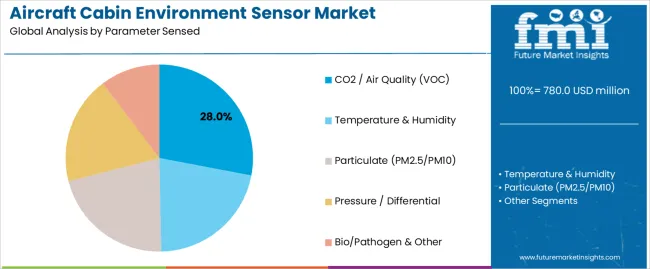
Market Position: CO2 / Air Quality (VOC) sensor systems command the leading position in the aircraft cabin environment sensor market with 28% market share through advanced detection features, including superior air quality monitoring, operational reliability, and passenger safety optimization that enable aircraft operators to achieve optimal cabin environmental consistency across diverse commercial and business aviation environments.
Value Drivers: The segment benefits from airline preference for reliable sensing systems that provide consistent air quality performance, rapid response time, and operational efficiency optimization without requiring significant infrastructure modifications. Advanced design features enable automated alert systems, concentration monitoring, and integration with existing aircraft environmental control equipment, where operational performance and regulatory compliance represent critical operational requirements.
Competitive Advantages: CO2 / Air Quality sensor systems differentiate through proven operational reliability, consistent detection characteristics, and integration with automated cabin management systems that enhance aircraft effectiveness while maintaining optimal safety standards suitable for diverse commercial and business aviation applications.
Key market characteristics:
Temperature & Humidity sensing systems maintain a 27% market position in the aircraft cabin environment sensor market due to their fundamental monitoring properties and operational advantages. These systems appeal to aircraft operators requiring comprehensive environmental control with baseline monitoring for passenger comfort applications. Market growth is driven by aviation expansion, emphasizing reliable sensing solutions and operational efficiency through optimized system designs.
Particulate (PM2.5/PM10) sensors capture 20% market share through specialized monitoring requirements in commercial aircraft, business aviation, and fleet modernization applications. These operators demand precise particle detection systems capable of handling diverse cabin environments while providing effective monitoring capabilities and operational accuracy.
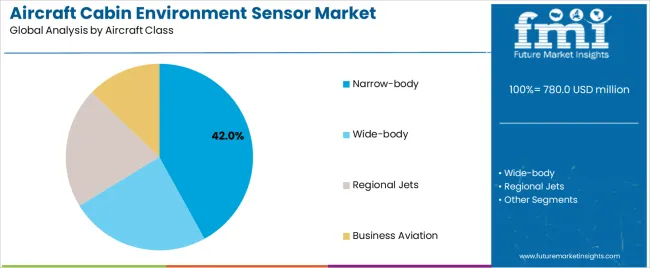
Market Context: Narrow-body aircraft demonstrate the highest market position in the aircraft cabin environment sensor market with 42% share due to widespread deployment of commercial aviation platforms and increasing focus on passenger safety optimization, operational fleet size, and cabin comfort applications that maximize environmental monitoring while maintaining safety standards.
Appeal Factors: Narrow-body aircraft operators prioritize system reliability, installation simplicity, and integration with existing environmental control infrastructure that enables coordinated sensing operations across multiple flight cycles. The segment benefits from substantial commercial aviation investment and fleet expansion programs that emphasize the acquisition of advanced sensor systems for safety optimization and passenger comfort applications.
Growth Drivers: Commercial aviation expansion programs incorporate cabin environment sensors as standard equipment for safety operations, while airline fleet growth increases demand for comprehensive monitoring capabilities that comply with safety standards and minimize operational complexity.
Market Challenges: Varying aircraft configurations and retrofit complexity may limit system standardization across different platforms or operational scenarios.
Application dynamics include:
Wide-body applications capture 28% market share through specialized monitoring requirements in long-haul operations, international routes, and premium cabin applications. These aircraft demand comprehensive sensor systems capable of operating across extended flight durations while providing effective environmental monitoring and operational reliability capabilities.
Regional jets applications account for 18% market share, including short-haul operations, regional connectivity, and commuter aircraft requiring efficient monitoring capabilities for operational optimization and passenger safety.
Market Position: Line-fit (OEM) installations command significant market position with 65% share through integrated deployment that meets new aircraft manufacturing and production line efficiency for commercial aviation applications.
Value Drivers: This installation approach provides the ideal combination of system integration and manufacturing efficiency, meeting requirements for airworthiness certification, quality assurance, and aircraft production without installation complexity or retrofit challenges.
Growth Characteristics: The segment benefits from broad applicability across aircraft manufacturing programs, standardized installation specifications, and established production systems that support widespread adoption and operational efficiency.
Market Context: Airframe OEM dominate the market with 55% share, reflecting the primary demand source for cabin environment sensor technology in aircraft manufacturing and production operations.
Business Model Advantages: Airframe manufacturers provide direct market demand for advanced sensing equipment, driving technology innovation and system integration while maintaining quality control and certification requirements.
Operational Benefits: OEM applications include aircraft development, production integration, and quality assurance that drive consistent demand for sensing equipment while providing access to latest monitoring technologies.
| Category | Factor | Impact | Why It Matters |
|---|---|---|---|
| Driver | Post-pandemic air quality focus & passenger health concerns | ★★★★★ | Heightened awareness requires comprehensive monitoring; operators investing in advanced air quality systems to ensure passenger confidence and regulatory compliance. |
| Driver | Regulatory compliance & airworthiness requirements (FAA, EASA standards) | ★★★★★ | Turns advanced sensing systems from "optional" to "mandatory"; vendors that provide certification support and compliance documentation gain competitive advantage. |
| Driver | Fleet modernization & retrofit programs | ★★★★☆ | Aging aircraft need sensor upgrades; demand for compatible systems with existing environmental control infrastructure expanding addressable market. |
| Restraint | High certification costs & lengthy approval cycles (especially for new sensors) | ★★★★☆ | Small operators defer upgrades; increases price sensitivity and slows advanced sensor adoption in regional aviation markets. |
| Restraint | Complex integration with legacy aircraft systems | ★★★☆☆ | Older aircraft face compatibility challenges and validation requirements, limiting retrofit flexibility and increasing installation complexity. |
| Trend | Smart cabin integration & predictive maintenance | ★★★★★ | Real-time monitoring, failure prediction, and data analytics transform operations; connectivity and digital integration become core value propositions. |
| Trend | Multi-parameter sensing & integrated suites | ★★★★☆ | Comprehensive environmental monitoring for multiple parameters; modular designs and sensor fusion capabilities drive competition toward integrated solutions. |
The aircraft cabin environment sensor market demonstrates varied regional dynamics with Growth Leaders including China (5.8% growth rate) and Brazil (5.4% growth rate) driving expansion through aviation fleet initiatives and commercial aircraft capacity development. Steady Performers encompass United States (4.3% growth rate), United Kingdom (4.3% growth rate), Germany (4.2% growth rate), and developed regions, benefiting from established aviation industries and advanced sensor technology adoption. Emerging Markets feature South Korea (3.8% growth rate) and Japan (3.1% growth rate), where aviation modernization and fleet upgrades support consistent growth patterns.
Regional synthesis reveals East Asian markets leading adoption through commercial aviation expansion and fleet development, while North American countries maintain steady expansion supported by aviation technology advancement and regulatory standardization requirements. European markets show moderate growth driven by aircraft modernization applications and safety integration trends.
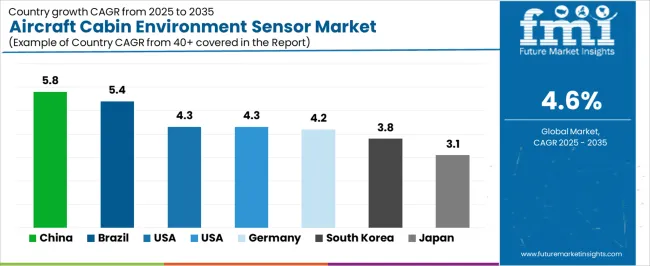
| Region/Country | 2025-2035 Growth | How to win | What to watch out |
|---|---|---|---|
| China | 5.8% | Lead with cost-effective integrated systems | Localization requirements; certification timelines |
| Brazil | 5.4% | Value-oriented retrofit solutions | Import duties; currency fluctuations |
| United States | 4.3% | Provide FAA certification support | Lengthy approval cycles; retrofit complexity |
| United Kingdom | 4.3% | Offer premium monitoring systems | Post-Brexit regulatory changes; operator consolidation |
| Germany | 4.2% | Push precision sensor technology | Over-engineering; lengthy validation processes |
| South Korea | 3.8% | Focus on OEM partnerships | Limited domestic production; import dependency |
| Japan | 3.1% | Premium quality systems | Aging fleet challenges; conservative adoption |
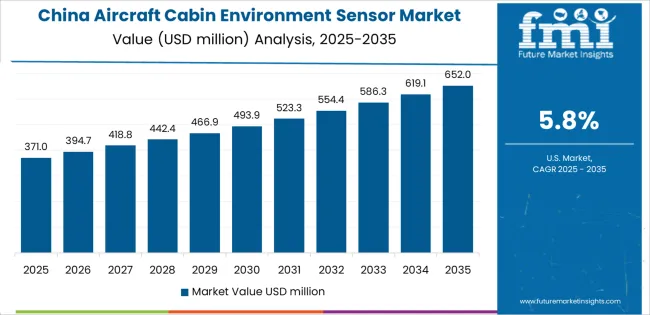
China establishes fastest market growth through aggressive commercial aviation programs and comprehensive fleet capacity development, integrating advanced cabin environment sensors as standard components in new aircraft deliveries and fleet modernization installations. The country's 5.8% growth rate reflects government initiatives promoting aviation expansion and domestic manufacturing capabilities that mandate the use of advanced sensing systems in commercial and business aircraft facilities. Growth concentrates in major aviation hubs, including Beijing, Shanghai, and Guangzhou, where aircraft technology development showcases integrated sensor systems that appeal to airline operators seeking advanced safety optimization capabilities and environmental monitoring applications.
Chinese manufacturers are developing cost-effective sensing solutions that combine domestic production advantages with advanced operational features, including automated monitoring systems and enhanced accuracy capabilities. Distribution channels through aircraft equipment suppliers and maintenance service distributors expand market access, while government support for aviation development supports adoption across diverse commercial and business aviation segments.
Strategic Market Indicators:
In São Paulo, Rio de Janeiro, and Brasília, commercial aviation operators and aircraft maintenance facilities are implementing advanced cabin environment sensors as standard equipment for passenger safety optimization and regulatory compliance applications, driven by increasing airline investment and fleet modernization programs that emphasize the importance of air quality monitoring capabilities. The market holds a 5.4% growth rate, supported by government aviation initiatives and infrastructure development programs that promote advanced sensing systems for commercial and regional aircraft facilities. Brazilian operators are adopting sensor systems that provide consistent operational performance and compliance features, particularly appealing in urban regions where passenger safety and comfort standards represent critical operational requirements.
Market expansion benefits from growing commercial aviation capabilities and international technology partnerships that enable local deployment of advanced sensing systems for aviation applications. Technology adoption follows patterns established in aircraft safety equipment, where reliability and performance drive procurement decisions and operational deployment.
Market Intelligence Brief:
United States establishes market leadership through comprehensive aviation programs and advanced aircraft infrastructure development, integrating cabin environment sensors across commercial and business aviation applications. The country's 4.3% growth rate reflects established aviation industry relationships and mature sensor technology adoption that supports widespread use of precision monitoring systems in commercial aircraft and maintenance facilities. Growth concentrates in major aviation centers, including Seattle, Atlanta, and Dallas, where aircraft technology showcases mature sensor deployment that appeals to airline operators seeking proven air quality monitoring capabilities and operational safety applications.
American equipment providers leverage established distribution networks and comprehensive service capabilities, including FAA certification programs and maintenance support that create customer relationships and operational advantages. The market benefits from mature regulatory standards and aviation requirements that mandate sensor system use while supporting technology advancement and operational optimization.
Market Intelligence Brief:
United Kingdom's advanced aviation technology market demonstrates sophisticated cabin environment sensor deployment with documented operational effectiveness in commercial aircraft applications and maintenance facilities through integration with existing environmental control systems and aircraft infrastructure. The country leverages aerospace expertise in aviation technology and safety systems integration to maintain a 4.3% growth rate. Aviation centers, including London, Manchester, and Birmingham, showcase premium installations where sensor systems integrate with comprehensive aircraft platforms and cabin management systems to optimize passenger safety operations and environmental effectiveness.
British manufacturers prioritize system accuracy and EASA compliance in sensing equipment development, creating demand for premium systems with advanced features, including aircraft monitoring integration and automated alert systems. The market benefits from established aviation technology infrastructure and a willingness to invest in advanced safety technologies that provide operational benefits and compliance with international aviation standards.
Market Intelligence Brief:
Germany's advanced aerospace technology market demonstrates sophisticated cabin environment sensor deployment with documented operational effectiveness in commercial aviation applications and aircraft manufacturing facilities through integration with existing quality systems and aviation infrastructure. The country leverages engineering expertise in aerospace technology and precision systems integration to maintain a 4.2% growth rate. Industrial centers, including Hamburg, Munich, and Frankfurt, showcase premium installations where sensor systems integrate with comprehensive aircraft platforms and manufacturing systems to optimize production operations and safety effectiveness.
German manufacturers prioritize system precision and EU compliance in sensing equipment development, creating demand for premium systems with advanced features, including manufacturing monitoring integration and automated quality systems. The market benefits from established aerospace technology infrastructure and investment in advanced aviation technologies that provide operational benefits and compliance with international aerospace standards.
Market Intelligence Brief:
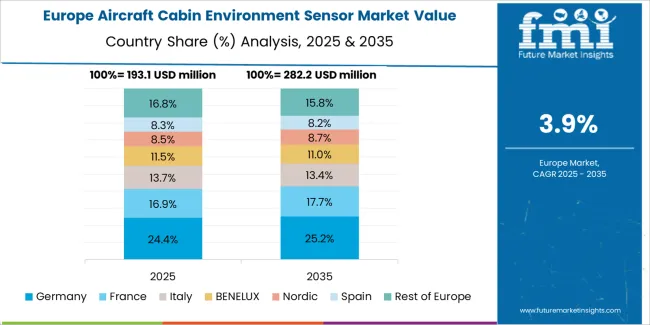
The aircraft cabin environment sensor market in Europe is projected to grow from USD 242 million in 2025 to USD 381 million by 2035, registering a CAGR of 4.6% over the forecast period. Germany is expected to maintain its leadership position with a 32.4% market share in 2025, supported by its advanced aerospace technology infrastructure and major aviation manufacturing centers including Hamburg and Munich.
United Kingdom follows with a 26.7% share in 2025, driven by comprehensive aviation programs and aircraft technology development initiatives. France holds a 19.8% share through specialized aerospace applications and safety compliance requirements. Italy commands a 11.2% share, while Spain accounts for 9.9% in 2025. The rest of Europe region is anticipated to maintain momentum at 6.5% by 2035, attributed to increasing sensor adoption in Nordic countries and emerging aviation facilities implementing fleet modernization programs.
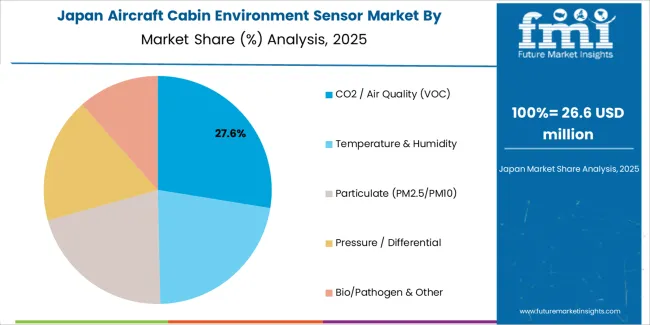
Japan maintains measured growth through established aerospace manufacturing relationships and comprehensive quality standards, with Tokyo, Osaka, and Nagoya regions demonstrating advanced sensor deployment in commercial aircraft and aviation technology centers. The market emphasizes precision engineering and regulatory compliance, where sensor systems integrate with aircraft manufacturing platforms and maintenance operations. Operators prioritize equipment longevity and certification standards, creating stable demand for premium sensing solutions with proven operational effectiveness.
South Korea's aviation technology sector advances through government aerospace programs and commercial aircraft partnerships, with Seoul and Busan regions implementing sensor systems for aviation manufacturing and maintenance applications. Growth reflects strategic aviation development initiatives and increasing domestic aircraft production capabilities. Market dynamics emphasize technology transfer partnerships and local manufacturing development, where international collaboration supports sensor technology advancement and operational deployment across commercial aviation segments.
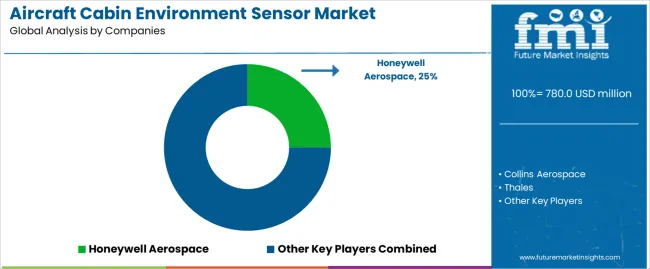
The competitive structure comprises 18-22 credible players with the top 4-5 manufacturers holding approximately 62-68% market share by revenue. Leadership is maintained through certification networks, technical support capabilities, and technology innovation encompassing accuracy, response time, and digital integration features. Basic sensing mechanisms and standard monitoring interfaces are commoditizing, while margin opportunities concentrate in certification services, calibration programs, and integration into airline operational workflows including aircraft management systems and digital maintenance records.
Global platforms control distribution reach through extensive service networks, proven reliability across aircraft types, and multi-region support infrastructure, though they face challenges in rapid technology refresh cycles and dependency on OEM relationships. Technology innovators maintain R&D capabilities in multi-parameter sensing and precision detection systems with advanced digital interfaces, offering latest features first and attractive return on investment for high-volume operators, but encounter service density limitations outside core aviation markets and complexity in customization requirements.
Regional specialists provide local certification expertise, rapid delivery capabilities, and nearby technical support teams, offering close-to-site service advantages with pragmatic pricing and local regulatory knowledge, though they face technology gaps compared to global leaders and talent retention challenges in technical service organizations. Service-focused ecosystems deliver comprehensive certification support, maintenance agreements, and component availability programs, achieving lowest operational downtime through extensive support coverage, but must manage service costs carefully to avoid overpromising while addressing technology obsolescence concerns.
Niche specialists concentrate on specialized aviation applications, custom sensing solutions, and research program support, winning development applications and flexible configuration requirements, but face scalability limitations and narrow market focus constraints. The competitive landscape emphasizes the critical importance of certification expertise and service network density, where manufacturers capable of providing comprehensive validation support and rapid technical assistance gain sustainable advantages in airline and OEM relationships while pure product suppliers face increasing margin pressure and commoditization risks.
| Item | Value |
|---|---|
| Quantitative Units | USD 780 million |
| Parameter Sensed | CO2 / Air Quality (VOC), Temperature & Humidity, Particulate (PM2.5/PM10), Pressure / Differential, Bio/Pathogen & Other |
| Aircraft Class | Narrow-body, Wide-body, Regional Jets, Business Aviation |
| Installation | Line-Fit (OEM), Retrofit/MRO |
| End Customer | Airframe OEM (Airbus/Boeing/Others), Airlines & Operators, MROs & Integrators |
| Regions Covered | North America, Latin America, Western Europe, Eastern Europe, East Asia, South Asia Pacific, Middle East & Africa |
| Countries Covered | United States, China, Germany, Japan, United Kingdom, Brazil, South Korea, France, Canada, and 20+ additional countries |
| Key Companies Profiled | Honeywell Aerospace, Collins Aerospace, Thales, TE Connectivity, Amphenol Advanced Sensors, Sensirion, Parker Meggitt, L3Harris (Aero Sensors), ITT Aerospace Controls, Korry (Safran Cabin) |
| Additional Attributes | Dollar sales by parameter type and aircraft class categories, regional adoption trends across North America, East Asia, and Western Europe, competitive landscape with aerospace equipment manufacturers and airline suppliers, aircraft operator preferences for air quality monitoring and system reliability, integration with aircraft environmental control platforms and cabin management systems, innovations in sensing technology and accuracy enhancement, and development of integrated sensor solutions with enhanced performance and aviation safety optimization capabilities. |
The global aircraft cabin environment sensor market is estimated to be valued at USD 780.0 million in 2025.
The market size for the aircraft cabin environment sensor market is projected to reach USD 1,223.0 million by 2035.
The aircraft cabin environment sensor market is expected to grow at a 4.6% CAGR between 2025 and 2035.
The key product types in aircraft cabin environment sensor market are co2 / air quality (voc), temperature & humidity, particulate (pm2.5/pm10), pressure / differential and bio/pathogen & other.
In terms of aircraft class, narrow-body segment to command 42.0% share in the aircraft cabin environment sensor market in 2025.






Full Research Suite comprises of:
Market outlook & trends analysis
Interviews & case studies
Strategic recommendations
Vendor profiles & capabilities analysis
5-year forecasts
8 regions and 60+ country-level data splits
Market segment data splits
12 months of continuous data updates
DELIVERED AS:
PDF EXCEL ONLINE
Aircraft Flight Control System Market Size and Share Forecast Outlook 2025 to 2035
Aircraft Electric Motor Market Forecast Outlook 2025 to 2035
Aircraft Cooling Turbines Market Size and Share Forecast Outlook 2025 to 2035
Aircraft Smoke Detection and Fire Extinguishing System Market Size and Share Forecast Outlook 2025 to 2035
Aircraft Hose Fittings Market Size and Share Forecast Outlook 2025 to 2035
Aircraft Galley Systems Market Size and Share Forecast Outlook 2025 to 2035
Aircraft Interior Lighting Market Size and Share Forecast Outlook 2025 to 2035
Aircraft Battery Market Size and Share Forecast Outlook 2025 to 2035
Aircraft Floor Panels Market Size and Share Forecast Outlook 2025 to 2035
Aircraft Fuel Systems Market Size and Share Forecast Outlook 2025 to 2035
Aircraft Lubricant Market Size and Share Forecast Outlook 2025 to 2035
Aircraft Seat Market Size and Share Forecast Outlook 2025 to 2035
Aircraft Ground Support Equipment Market Size and Share Forecast Outlook 2025 to 2035
Aircraft Maintenance, Repair and Overhaul Market Size and Share Forecast Outlook 2025 to 2035
Aircraft Actuators Market Size and Share Forecast Outlook 2025 to 2035
Aircraft Elevator Market Size and Share Forecast Outlook 2025 to 2035
Aircraft Weapons Market Size and Share Forecast Outlook 2025 to 2035
Aircraft Lighting Market Size and Share Forecast Outlook 2025 to 2035
Aircraft Micro Turbine Engines Market Size and Share Forecast Outlook 2025 to 2035
Aircraft De-icing Market Size and Share Forecast Outlook 2025 to 2035

Thank you!
You will receive an email from our Business Development Manager. Please be sure to check your SPAM/JUNK folder too.
Chat With
MaRIA